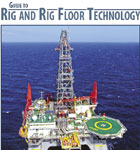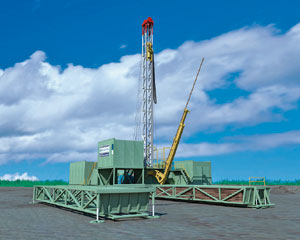New rig designs: Scaled-down, new rig type for shallow gas drilling
December 2004 Supplement New Rig Designs Scaled-down new rig type for
Scaled-down new rig type for shallow gas drillingPrecision Drilling’s latest innovation in rig design is a fit-for-purpose, scaled-down version of its versatile Super Single rig. Developed for shallow gas drilling, the Super Single Light (SSL) provides the advantages of jointed-pipe operations with the high penetration rates (ROP), and mobility of a coiled-tubing unit.
The new rig design was prompted by recognition that, while shallow gas operations benefit from faster mobilization and greater ROP exhibited by coiled-tubing drilling, continuous-tubing rigs are limited in their range of application. The new design was developed to meet operator needs in applications that also require use of Range III jointed tubulars. Introduced in 2004, the new rig has significantly increased both operational efficiency and drilling economics. For example, in early applications, the new rigs drilled a shallow gas project in NE British Columbia, and a horizontal, heavy oil project in East Central Alberta, ahead of schedule and under budget. In a 200-well project for operator EOG, ROP was comparable to a coiled-tubing unit. Operator figures in the Drumheller field in Alberta, Canada, recorded conventional rig ROP of 70 m/hr and coiled-tubing rates of 140 to 180 m/hr. The new SSL achieved rates of 150 m/hr. When coiled-tubing drilling was introduced to the Western Canada shallow gas market in the mid-1990s, its faster mobilization and higher ROP were advantages compared to conventional drilling rigs. But coiled tubing also has operational limits, such as in fishing operations, where a conventional, jointed-pipe rig is the only solution. The SSL’s high ROP and mobility, combined with its jointed-tubular operation, provides the flexibility needed to optimize performance and economics in these applications. In developing the scaled-down rig, Precision’s engineers used the proven Super Single design as a starting point. As a result, the “Light” version includes many of the design’s safety and operation-enhancing features, along with a few innovations of its own. Among the features retained from the larger rig version are its automated pipe handling and top drive systems, which have proven records of reducing injuries and repetitive tasks, and improving drilling efficiencies. The greatest overall design change relates directly to mobility. The new design can be moved in only nine loads – four less than a Super Single (depending on pipe load). With the exception of drill pipe and mud tank, all loads are wheel-mounted, allowing fast transport to the next location using only a tractor. Light also refers to the shallow drilling capacity. Compared to the 2,200-m and 3,000-m depth ranges of individual Super Single models, the shallow-gas Light version has a depth capacity of just 1,200 m and a static load of 100,000 lb, vs. 250,000 lb. Because of its shallow drilling target market, the new rig is a vertical-mast design compared to the slant capability of the Super Single, allowing a significant reduction in weight and number of loads. Where jointed-tubular operations provide an advantage, the Super Single Light is providing operators with a proven alternative to conventional rigs, while allowing them to retain key benefits of a coiled tubing unit. |
|||||||||
- Coiled tubing drilling’s role in the energy transition (March 2024)
- Using data to create new completion efficiencies (February 2024)
- Digital tool kit enhances real-time decision-making to improve drilling efficiency and performance (February 2024)
- E&P outside the U.S. maintains a disciplined pace (February 2024)
- U.S. operators reduce activity as crude prices plunge (February 2024)
- Drilling advances (January 2024)
- Applying ultra-deep LWD resistivity technology successfully in a SAGD operation (May 2019)
- Adoption of wireless intelligent completions advances (May 2019)
- Majors double down as takeaway crunch eases (April 2019)
- What’s new in well logging and formation evaluation (April 2019)
- Qualification of a 20,000-psi subsea BOP: A collaborative approach (February 2019)
- ConocoPhillips’ Greg Leveille sees rapid trajectory of technical advancement continuing (February 2019)




